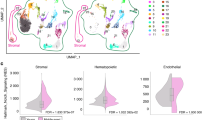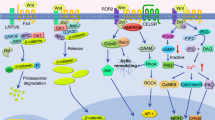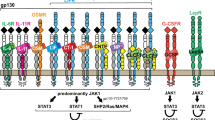Abstract
Notch signaling is a key mechanism in the control of embryogenesis. However, its in vivo function during mesenchymal cell differentiation, and, specifically, in bone homeostasis, remains largely unknown. Here, we show that osteoblast-specific gain of Notch function causes severe osteosclerosis owing to increased proliferation of immature osteoblasts. Under these pathological conditions, Notch stimulates early osteoblastic proliferation by upregulating the genes encoding cyclin D, cyclin E and Sp7 (osterix). The intracellular domain of Notch1 also regulates terminal osteoblastic differentiation by directly binding Runx2 and repressing its transactivation function. In contrast, loss of all Notch signaling in osteoblasts, generated by deletion of the genes encoding presenilin-1 and presenilin-2 in bone, is associated with late-onset, age-related osteoporosis, which in turn results from increased osteoblast-dependent osteoclastic activity due to decreased osteoprotegerin mRNA expression in these cells. Together, these findings highlight the potential dimorphic effects of Notch signaling in bone homeostasis and may provide direction for novel therapeutic applications.
This is a preview of subscription content, access via your institution
Access options
Subscribe to this journal
Receive 12 print issues and online access
$209.00 per year
only $17.42 per issue
Buy this article
- Purchase on SpringerLink
- Instant access to full article PDF
Prices may be subject to local taxes which are calculated during checkout





Similar content being viewed by others
References
Artavanis-Tsakonas, S., Rand, M.D. & Lake, R.J. Notch signaling: cell fate control and signal integration in development. Science 284, 770–776 (1999).
Bray, S.J. Notch signalling: a simple pathway becomes complex. Nat. Rev. Mol. Cell Biol. 7, 678–689 (2006).
Weinmaster, G. The ins and outs of Notch signaling. Mol. Cell. Neurosci. 9, 91–102 (1997).
Daudet, N. & Lewis, J. Two contrasting roles for Notch activity in chick inner ear development: specification of prosensory patches and lateral inhibition of hair-cell differentiation. Development 132, 541–551 (2005).
Brennan, C.A. & Moses, K. Determination of Drosophila photoreceptors: timing is everything. Cell. Mol. Life Sci. 57, 195–214 (2000).
Bulman, M.P. et al. Mutations in the human delta homologue, DLL3, cause axial skeletal defects in spondylocostal dysostosis. Nat. Genet. 24, 438–441 (2000).
Shen, J. et al. Skeletal and CNS defects in presenilin-1–deficient mice. Cell 89, 629–639 (1997).
Deregowski, V., Gazzerro, E., Priest, L., Rydziel, S. & Canalis, E. Notch 1 overexpression inhibits osteoblastogenesis by suppressing Wnt/β-catenin but not bone morphogenetic protein signaling. J. Biol. Chem. 281, 6203–6210 (2006).
Sakamoto, K., Chao, W.S., Katsube, K. & Yamaguchi, A. Distinct roles of EGF repeats for the Notch signaling system. Exp. Cell Res. 302, 281–291 (2005).
Sciaudone, M., Gazzerro, E., Priest, L., Delany, A.M. & Canalis, E. Notch 1 impairs osteoblastic cell differentiation. Endocrinology 144, 5631–5639 (2003).
Tezuka, K. et al. Stimulation of osteoblastic cell differentiation by Notch. J. Bone Miner. Res. 17, 231–239 (2002).
Zamurovic, N., Cappellen, D., Rohner, D. & Susa, M. Coordinated activation of Notch, Wnt, and transforming growth factor-β signaling pathways in bone morphogenic protein 2–induced osteogenesis. Notch target gene Hey1 inhibits mineralization and Runx2 transcriptional activity. J. Biol. Chem. 279, 37704–37715 (2004).
Nakashima, K. et al. The novel zinc finger–containing transcription factor osterix is required for osteoblast differentiation and bone formation. Cell 108, 17–29 (2002).
Galindo, M. et al. The bone-specific expression of Runx2 oscillates during the cell cycle to support a G1-related antiproliferative function in osteoblasts. J. Biol. Chem. 280, 20274–20285 (2005).
Pratap, J. et al. Cell growth regulatory role of Runx2 during proliferative expansion of preosteoblasts. Cancer Res. 63, 5357–5362 (2003).
Shen, R. et al. Cyclin D1–cdk4 induce Runx2 ubiquitination and degradation. J. Biol. Chem. 281, 16347–16353 (2006).
Hill, T.P., Spater, D., Taketo, M.M., Birchmeier, W. & Hartmann, C. Canonical Wnt/β-catenin signaling prevents osteoblasts from differentiating into chondrocytes. Dev. Cell 8, 727–738 (2005).
Day, T.F., Guo, X., Garrett-Beal, L. & Yang, Y. Wnt/β-catenin signaling in mesenchymal progenitors controls osteoblast and chondrocyte differentiation during vertebrate skeletogenesis. Dev. Cell 8, 739–750 (2005).
Glass, D.A., II et al. Canonical Wnt signaling in differentiated osteoblasts controls osteoclast differentiation. Dev. Cell 8, 751–764 (2005).
Krishnan, V., Bryant, H.U. & Macdougald, O.A. Regulation of bone mass by Wnt signaling. J. Clin. Invest. 116, 1202–1209 (2006).
Tu, X. et al. Noncanonical Wnt signaling through G protein–linked PKC-δ activation promotes bone formation. Dev. Cell 12, 113–127 (2007).
Janssens, K., ten Dijke, P., Janssens, S. & Van Hul, W. Transforming growth factor-β1 to the bone. Endocr. Rev. 26, 743–774 (2005).
Mezquita-Raya, P. et al. The contribution of serum osteoprotegerin to bone mass and vertebral fractures in postmenopausal women. Osteoporos. Int. 16, 1368–1374 (2005).
Fahrleitner-Pammer, A. et al. Osteoprotegerin serum levels in women: correlation with age, bone mass, bone turnover and fracture status. Wien. Klin. Wochenschr. 115, 291–297 (2003).
Arko, B., Prezelj, J., Kocijancic, A., Komel, R. & Marc, J. Association of the osteoprotegerin gene polymorphisms with bone mineral density in postmenopausal women. Maturitas 51, 270–279 (2005).
Choi, J.Y. et al. Genetic polymorphisms of OPG, RANK, and ESR1 and bone mineral density in Korean postmenopausal women. Calcif. Tissue Int. 77, 152–159 (2005).
Hofbauer, L.C. et al. Estrogen stimulates gene expression and protein production of osteoprotegerin in human osteoblastic cells. Endocrinology 140, 4367–4370 (1999).
Bucay, N. et al. Osteoprotegerin-deficient mice develop early onset osteoporosis and arterial calcification. Genes Dev. 12, 1260–1268 (1998).
Wang, L.L. Biology of osteogenic sarcoma. Cancer J. 11, 294–305 (2005).
Boyce, B.F. & Xing, L. Osteoclasts, no longer osteoblast slaves. Nat. Med. 12, 1356–1358 (2006).
Zhao, C. et al. Bidirectional ephrinB2-EphB4 signaling controls bone homeostasis. Cell Metab. 4, 111–121 (2006).
Zhou, G. et al. Dominance of SOX9 function over RUNX2 during skeletogenesis. Proc. Natl. Acad. Sci. USA 103, 19004–19009 (2006).
Ducy, P. et al. A Cbfa1-dependent genetic pathway controls bone formation beyond embryonic development. Genes Dev. 13, 1025–1036 (1999).
Segall, H.I., Yoo, E. & Sutton, R.E. Characterization and detection of artificial replication-competent lentivirus of altered host range. Mol. Ther. 8, 118–129 (2003).
Dai, C., McAninch, R.E. & Sutton, R.E. Identification of synthetic endothelial cell–specific promoters by use of a high-throughput screen. J. Virol. 78, 6209–6221 (2004).
Sutton, R.E., Wu, H.T., Rigg, R., Bohnlein, E. & Brown, P.O. Human immunodeficiency virus type 1 vectors efficiently transduce human hematopoietic stem cells. J. Virol. 72, 5781–5788 (1998).
Xing, L. et al. NF-κB p50 and p52 expression is not required for RANK-expressing osteoclast progenitor formation but is essential for RANK- and cytokine-mediated osteoclastogenesis. J. Bone Miner. Res. 17, 1200–1210 (2002).
Acknowledgements
We thank T. Kadesch (University of Pennsylvania) for Myc-His–tagged N1ICD, GST-NICDΔTAD and GST-NICDΔRA, G. Karsenty (Columbia University) for Col1a1-Cre mice, M.S. Nanes (Emory University) for osterix-luciferase and −1269/91 Osx-p-luc, and L. Donehower (Baylor College of Medicine) for antibody to p53. We thank M. Acar and O. Sirin for technical assistance. This work was supported by US National Institutes of Health grants ES11253 (B.L.), HD22657 (B.L.), DE016990 (B.L.) and AR43510 (B.F.B.).
Author information
Authors and Affiliations
Corresponding author
Supplementary information
Supplementary Text and Figures
Supplementary Figs. 1–4 and Supplementary Methods (PDF 2718 kb)
Rights and permissions
About this article
Cite this article
Engin, F., Yao, Z., Yang, T. et al. Dimorphic effects of Notch signaling in bone homeostasis. Nat Med 14, 299–305 (2008). https://doi.org/10.1038/nm1712
Received:
Accepted:
Published:
Issue Date:
DOI: https://doi.org/10.1038/nm1712



